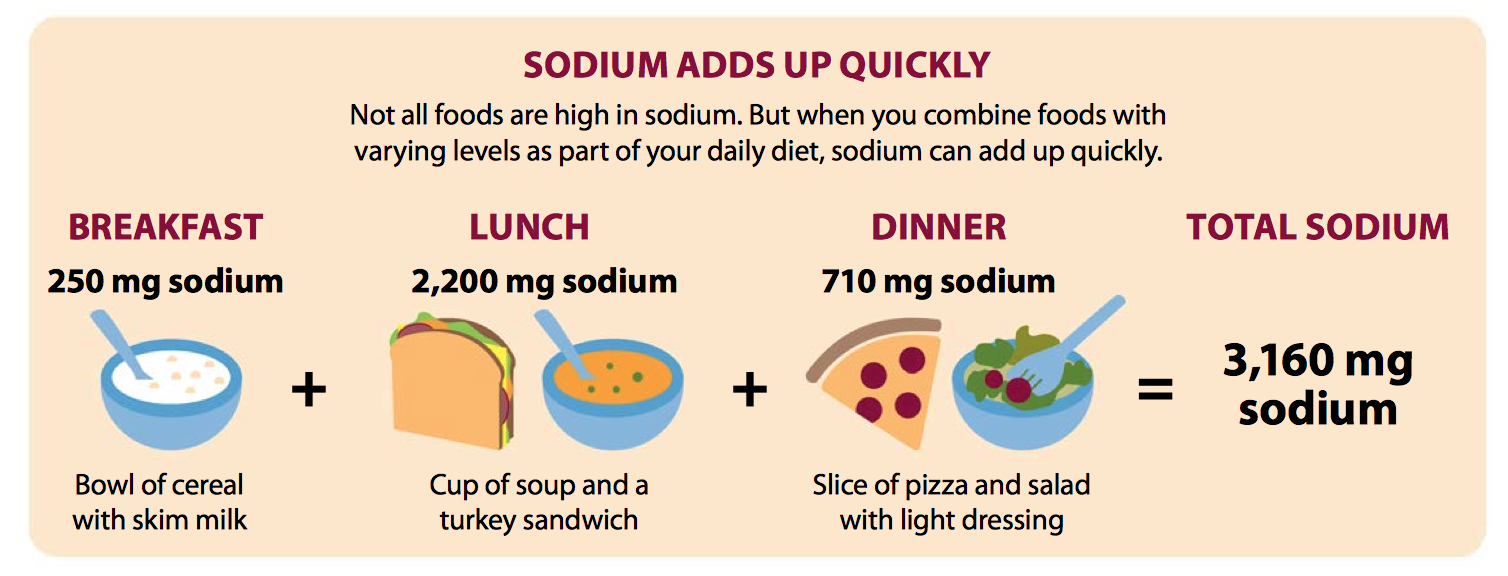
FEATURE — Salt, also known as sodium, tends to get a bad rap in the nutrition world. Your body actually needs salt. The problem is that most people get much more than they need. When this happens, it is time to halt the salt!

Too much sodium puts you at risk for developing high blood pressure, heart disease and stroke. Sodium may be present in your diet in a variety of ways, including the following:
- It is naturally occurring in some foods.
- It is added during cooking and and while eating.
- Most processed foods contain a high amount of sodium.
The USDA’s Dietary Guidelines recommend no more than 2,300 milligrams, about one teaspoon, per day. The CDC provides a great graphic showing how quickly sodium intake can add up throughout the day. As you can see, it doesn’t take much to exceed 2,300 milligrams.
Follow these 10 tips to halt the salt and stay within the recommended amount of sodium in your diet.
Eat more fresh fruits and vegetables and low-fat dairy. Foods like bananas, spinach, low-fat yogurt and potatoes are low in sodium and high in potassium. This is a great combination for reducing blood pressure and increasing heart health.
When eating frozen and canned vegetables, choose the low-sodium option or those without added salt. Rinsing veggies from a can before eating them can also help reduce the amount of sodium.

When buying processed foods, read the nutrition label. Choose the option with less sodium. Those containing 140 milligrams or less per serving are considered a low-sodium option. Even better, those with 35 milligrams or less are considered very low in sodium.
Instead of choosing already prepared and ready-to-eat products, opt for fresh or frozen poultry, seafood and lean meats.
Cook more often at home. Eating at home means you are in charge of what goes into your food, giving you the opportunity to halt the salt.
Avoid using salt as your seasoning. Instead, use lemon juice, garlic, pepper and other herbs and spices free of salt. Check out a list of homemade spices by clicking here.
Choose your condiments wisely. Things like salad dressing, ketchup and soy sauce, for example can be high in sodium. Read the nutrition label or learn how to make your own alternative at home that has less salt.
Taste your food before you salt it. You may realize that you didn’t need that extra salt in the first place.
When eating out, check the menu online before you go and search out low-sodium options. Ask the cook to avoid salting your meal before he/she brings it out.

Be mindful of portion sizes. Bigger portions likely means more sodium. Watching your portion size will not only help with sodium intake, but with maintaining a healthy weight as well.
This Greek pasta salad recipe is a great low-sodium dinner option. With fresh ingredients and low-sodium seasoning, it’s very flavorful without all that added salt. Serve it with grilled chicken and a bowl of fresh fruit to make it a MyPlate meal. Enjoy!
Written by CANDI MERRITT, Certified Nutrition Education Ambassador.
This article originally appeared March 31, 2016, on the USU Extension Create Better Health blog.
Copyright © CreateBetterHealth.org, all rights reserved.